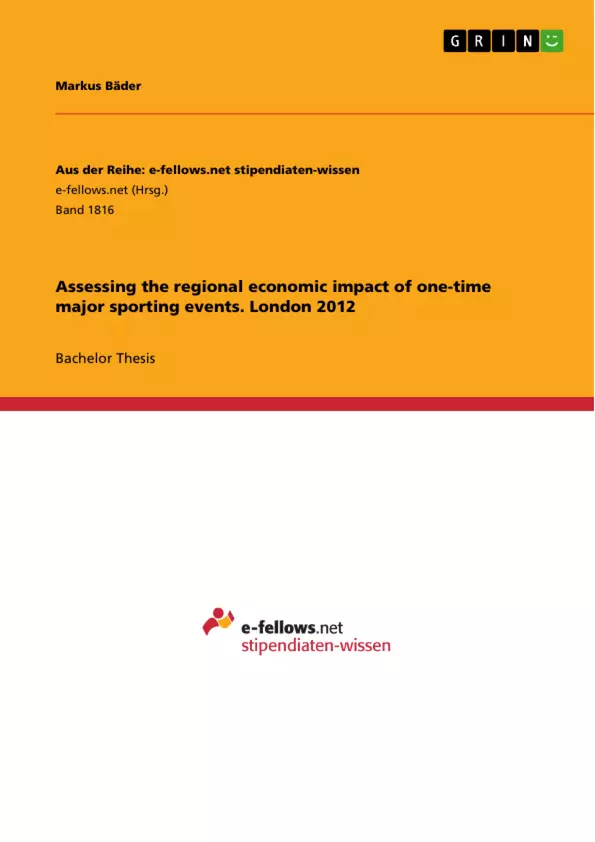The main objective of this study was to examine the existing economic impact studies on London 2012 after understanding the shortcomings of traditional methods and exploring advanced approaches.
In a first step this work has therefore focused on basic economic frameworks, namely Leontief’s IOA and the CBA, which have long been used in the event impact evaluations (Levy & Berger, 2013; Preuss, 2004a). Despite their straightforward application, both models reveal significant shortcomings, including the exaggeration of impacts and inability to address opportunity costs (IOA, cf. Lahr & Stevens, 2002) or specific economic situations (CBA, cf. Késenne, 2005).
As most of the weaknesses can be traced back to the use of economic multipliers (Preuss, 2004a), this study examined adjustments to the traditional models in a second step. Despite a more complicated realisation and its origin in US-specific data the, RIMSII and IMPLAN models, if at all, reduce the negative multiplier effects (Lynch, 2000; Rickman & Schwer, 1995). On this account, the GCE approach emerged and has been hailed a panacea by a number of event-assessing authors (Dwyer et al., 2004, 2006; Partridge & Rickman, 2010), notwithstanding the fact that the approach still fails to reduce the degree of subjectivity in the evaluation (Kasimati & Dawson, 2009).
In a third step, the valuation method of Preuss (2004a, 2004b) has been introduced since its different approach to regionalise the primary impact best fits this studies’ objective to present a model that assesses the regional impact of the Olympics.
Concluding with a review of five London 2012 studies, this work reveals that several attempts have been made to assess the economic consequences of the event on the British capital. Although a variety of models, including CGE (Blake, 2005), CBA (ARUP, 2002) and IOA (Oxford Economics, 2012), has been employed, it is the author’s belief that the literature still lacks a sufficient investigation on the city’s regional impact.
Inhaltsverzeichnis (Table of Contents)
- Introduction
- Rationale for the Literature Review
- Academic Objectives
- Outline and Structure
- Setting the Scene
- Literature Review
- Traditional Methods
- Economic Impact Analysis
- Use of Multipliers in EIA
- Cost Benefit Analysis
- Methods in Practice
- Adjusted Input-Output Approaches
- Computable General Equilibrium Approach
- Advanced Methodological Concept
- Regional Primary Impact
- Regional Input-Output Table
- Existing Studies on London 2012
- Summary
- Conclusion
- Limitations and Further Research
Zielsetzung und Themenschwerpunkte (Objectives and Key Themes)
This work aims to investigate the methodology of existing London 2012 impact-studies, specifically examining whether they adopted a holistic approach to assess the regional economic impact. It seeks to understand the shortcomings of traditional economic impact methods, explore adjusted methods used in practice, delve into an advanced methodological concept, and analyze current ex-ante and ex-post impact studies on the 2012 Olympic Games.
- Evaluating traditional economic impact analysis methods and their limitations.
- Examining adjusted input-output and computable general equilibrium approaches in event impact assessment.
- Exploring an advanced methodological concept for regional economic impact analysis.
- Investigating existing studies that have assessed the impact of the London 2012 Olympic Games.
- Assessing the overall impact of major sporting events, particularly the 2012 Olympic Games, on host communities.
Zusammenfassung der Kapitel (Chapter Summaries)
- Introduction: This chapter establishes the rationale behind the study, highlighting the need for reliable and objective assessments of the economic impact of major sporting events, particularly the London 2012 Olympic Games. It introduces the academic objectives and the structure of the project.
- Setting the Scene: This section will discuss the context of the study, examining various effects of the Games on host communities as identified in existing literature.
- Literature Review: This chapter delves into the methodological approaches used to assess the economic impact of major events. It explores traditional methods, including economic impact analysis, use of multipliers, and cost-benefit analysis. The chapter then examines adjusted methods like input-output approaches and the computable general equilibrium approach. Finally, it presents an advanced methodological concept for regional economic impact analysis, focusing on regional primary impact and regional input-output tables.
Schlüsselwörter (Keywords)
This work focuses on the economic impact of one-time major sporting events, particularly the London 2012 Olympic Games. Key areas of focus include regional economic impact analysis, event impact assessment, traditional and adjusted methodologies, input-output analysis, computable general equilibrium models, multiplier effects, cost-benefit analysis, and regional primary impact. The study examines existing impact studies and critically analyzes their methodologies to provide a comprehensive understanding of the economic impact of such events.
- Quote paper
- Markus Bäder (Author), 2015, Assessing the regional economic impact of one-time major sporting events. London 2012, Munich, GRIN Verlag, https://www.grin.com/document/323351



